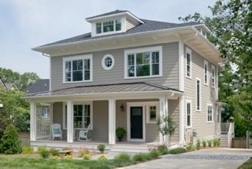When friends ask what my husband Mike Knezovich does for a living, it can be hard to explain. I tell them he’s the Director of Communications for Passive House Institute U.S (PHIUS). But what is a passive house, and what does PHIUS do?
Lucky for me, a writer from the Boston Globe bought a passive house last spring, and a personal essay she wrote about what it’s like to live there was published in last Sunday’s Boston Globe Magazine. Maria Cramer‘s article does a great job of explaining Passive House standards in a way that is easy to understand, and as a bonus, Mike is quoted at the end!
The Passive House Cramer and her husband bought has walls that are 17 inches thick, “The better to trap the heat from the sun shining through our huge windows, she wrote.” The house was built by Travis Anderson and Declan Keefe, who assured the homebuyers that their energy bills will be reduced to almost nothing. From the article:
The idea of heat staying trapped inside also made me realize that dead air would remain with it. As if reading my mind, Declan explained that a special vent system would filter out stale wire and draw in fresh wire. You’d just have to make sure you cleaned the filter every six months, he said. The place would run on electricity: Two small Mitsubishi devices, one on the first floor, the other on the second floor, would supply both heat and air conditioning. You’d use them about half as much as you would use a regular heater and air conditioner, Travis said. The sun would provide in the winter, they intoned. In the summer, keeping the windows open would bring in cool night air that we could trap in the morning by shutting the windows. The water would be heated by solar panels, backed up by an in-tank electric coil.
The article goes on to describe what its been like to live in the house so far. Cramer said that the long winter this year forced them to rely on the heat more than they’d planned to during their first month there. By April, though, the sun started shining directly into the kitchen, warming the concrete floor.
“On cool mornings, we no longer had to wear socks to stay warm.”
Their energy bills are a sixth of what they paid in their old place, and Cramer says she was pleasantly surprised to discover that in addition to keeping out the cold and humidity, the thick walls and triple-pane windows keep noise out, too. “At night, when our neighbors stay up late talking or when they set off firecrackers around July Fourth, we need only shut the windows.”
There are thousands of passive houses in Europe, but only about 120 certified and pre-certified structures in the United States. One unfortunate thing about the passive house name is that it implies the approach is only for single family homes. In fact, you can build anything, including skyscrapers, using passive building principles. Mike says that more an more multifamily buildings–apartments, row houses, etc.–are being submitted for certification. And it’s a natural for affordable housing developers, who are embracing it.
I’ll end this post with the best part of the Boston Globe Magazine article — a passage that includes Mike’s quote explaining why that is:
Still, that’s a big jump from 2012, when there were only about a dozen in the United States, according to Michael Knezovich, spokesman for the Passive House Institute US, which certifies the homes. (Not included in the count, Knezovich points out, are homes built to the passive standard but not certified, like the one featured here.) The increase, Knezovich says, is due to developers seeing value in formally validating homes as energy-efficient and home buyers becoming familiar with the passive home concept.“It’s very clear that more and more people are learning about it,” he says. “The early adopters were kind of tree-huggers. But [the houses] are very comfortable. They’re well built, and when people walk through one they say: ‘Oh, this isn’t a flaky thing. It’s not a sacrificial thing. You don’t have to wear a sweater all the time. It’s not just a do-gooder thing.’ These are really nice houses.”
If you want to immerse yourself in passive house, Mike’s organization (PHIUS) is putting on it’s 9th Annual North American Passive House Conference in the Bay Area September 10-14. You can learn more and register here.

Which Bay Area? SF?
-Bob
Yup. San Francisco Bay area.
_____
Hi Beth,
I have actually read about these houses. Must have been in the NYT within the last year or two.
Thanks for this. See you tomorrow.
Marjorie
Sent from my iPhone
>
That probably *is* where you heard about them Marjorie –Passive House has been covered in the new York Times, too –I just don’t think they quoted Michael Knezovich in those stories!
_____
How interesting! Monna
Leave a Response